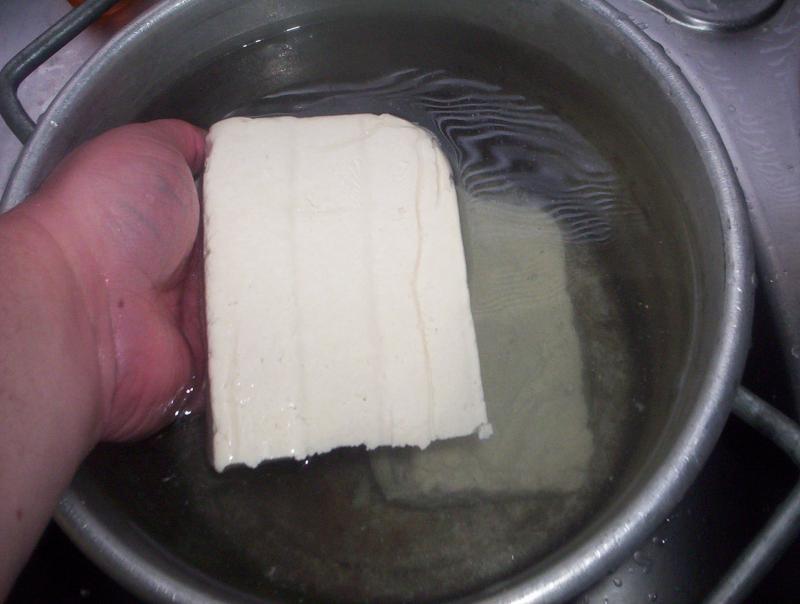-
Posts
269 -
Joined
-
Last visited
Content Type
Profiles
Forums
Store
Help Articles
Everything posted by TheTInCook
-
The color change happened before I rolled it. It was a nice shade of yellow for while after I mixed it. The flour is ConAgra All Purpose. While it was a bit disconcerting to see that grayish lump of dough, it didn't look so bad once I rolled and cut it. (Forgot to take a pic of the dough lump)
-
Guess I'm going to have to try the octo vin. So the dough turned out very very nice to roll. I rolled it number 5, and then cut it on the spegetti cutter. It didn't need flour at all when rolling, and it cut beautifully. The noodles stayed separate, though a very few seemed to break. Tomorrow I'm doing a ramen class at this place I volunteer at. We're going to do the Momofuku menma there, as well as go over some basic veggie cookery (Kholrabi, kabocha, and yu choy. I wanted them to taste some of the 'exotic' stuff while still learning how to make 'normal' veggies), and how to boil an egg. Not doing to the full momofuko broth. Instead, it's gonna be chicken stock and dashi, with mushroom stem. onion, and ginger. For the meats, I braised a beef shank in master sauce. That'll get either sliced or pulled ala Momofuku pork shoulder. Instead of pork belly, were doing some Chinese style char sui. I'm going to take a look at the book tommorrow to see if we have any easy pickles to make. I forgot to add, that since I was frying stuff for dinner, I might as well give my noodle nest a fry and see if I can make my own instant ramen. I think my oil might have been too hot for that process, since it started coloring before it was tottally dry in the center. It's drying uncovered on my counter.
-
Just checked my dough. I left it out, wrapped in plastic, at room temp for ~1.5 hours. Its got a nice texture, feels like it will roll well in the machine, BUT it's already starting to turn grey/green. Good thing this is a test batch.
-
Ok, just finished kneading till combined and fairly smooth. Didn't want to overwork it since I'm planning on running it through the pasta machine. I used the as printed amount of water and mixed by hand. 90-95% of the flour came together in a stiff ball. The rest were like cornmeal or bigger. Added >10ml addtional water to get them to aggregate. Makes me remember that I always seem to be making my noodle doughs too slack, so they get too soft when cooked.
-
shoot, no food processor. hopefully resting is enough.
-
I'm going to attempt the noodle dough recipe. I'm kinda worried because it has a really low dough hydration as written. Same with the MC recipe (did they just use his?)
-
In the MC Fried chicken, what was the baking soda for? Tenderization?
-
I'm just guessing here, but assuming the 60% dough hydration and ~1 oz raw scaling... at least 1200
-
Cool. I've always imagined yamok sauce would taste kinda like A1 steak sauce. No Romulan Ale? For shame...
-
The problem didn't reoccur, though the center seemed a tad more tender then usual.
-
Update: I defrosted the last bit of that ground beef yesterday. I made some zha jiang main with part of it last night, and it aquitited itself well. I'm about to make some kimchi mandu with the rest, adding raw egg to see if it helps with the bind. One thing that that didn't strike me as significant when I started the thread, but seems odd now, is that when I stirred the dumpling filling, some of the beef fat stuck to the spoon and the sides of the bowl.
-
Used to make eggs goldenrod for Easter brunch. Family tradition. Take hard boiled eggs, dice the whites and fold into warm bechamel, spoon over buttered sourdough toast, and top with the sieved yolks.
-
Neat video! I had no idea that sesame paste needed so much oil added to it. I'll try and get some of the tian mian jiang. I've never had it before. Always assumed it was just hoisin with out the five spice. This reminds me of a test I want to try. Roasting tahini to turn it into Asian style sesame paste. Be great to just have to stock the one jar.
-
Thanks guys! I've decided against getting an infrared thermometer for now. Since I'm putting together a sv rig anyway, I'm ordering a temp probe for it that can handle candy making and has a long protected cable.
-

Hummus: Additives, Techniques, Recipes
TheTInCook replied to a topic in Middle East & Africa: Cooking & Baking
The hummus I made this weekend had little bits of 'grit' in it no matter how much I pureed it. The beans took forever to get soft. I was using a normal pot, no soak, no salt, no soda, and the beans stayed underwater the entire time. Definitely going to use baking soda. -
Thanks! Can hoisin or yellow bean paste/huangdou jian be used in place of the sweet bean sauce? The doubanjiang is used raw and isn't fried first?
-
Anyone got a recipe/guidelines?
-
Cool use! I too am surprised at how tasty it can be. For dinner, I made some 'kibbe' kabobs with a couple of handfuls of my parched okara. Came out great.
-
I started keeping note books. Nothing special, just a note books for school from the dollar store. I put stuff in that I'm making, stuff I want to do, and the results of stuff I've done and changes to be made. Things like that. I only write on the front side of the pages, so the back is free for me to add stuff when I revisit the topic. That helps things from becoming fragmented. Got a bunch of stains too, since I take it into the kitchen often to use. I suppose you could do a similar thing with a text document on some sort of device, it'd be easily searchable that way. Pen and paper has just been easier for me to input. Hmm, just occured to me, a blog would be a great way to archive all that information because you could easily include pictures and share it with people, and get their inputs via comments.
-
Fourthing this. I cooked some chickpeas on thurs, pulled them out of the fridge on Friday to make hummus, and they were a little gloopy on top. Had the hummus for dinner that night, a little for breakfast, and about to have the rest for lunch. Hasn't made me sick.... yet...
-
I ended up tossing the okara with a little sugar and a little salt and parching it in a slow oven until it got golden. It's pretty interesting stuff. Surprisingly light and fluffy. Nice nutty taste. It's got a gentle crispness to it, almost like eating puffed grapenuts. The crispness dies very quickly when exposed to moisture, as I found out when I dumped a handful on my yogurt this morning. It'd make a great addition to granola. Might even make a good hot cereal. On her blog, Andrea Nugyen is using it as a gluten free 'panko' for frying.
-
Hmm, maybe check out Bruce Cost's book, Asian Ingredients. It usually has good coverage on how to use odd ingredients like that.
-
-
Just attempted my first block of tofu. It's pressing as I write. I made a 16 oz dry soybean batch (go big or go home, right?). Turning it into soymilk was pretty easy, though, next time I will puree the go a bit longer as my okara turned out a bit coarse. Since I needed to use the a big stock pot to cook all my soy milk, I decide to use the 'mainland' method (as described in the book of tofu, by Shurtleff and Aoyagi)vs the 'island' method used in Nguyen's book. In the 'mainland' method, the soy milk is cooked all in one stage, then pressed from the okara. In the 'island' method, the soy milk is cooked until the first big foam up, then is pressed from the okara, and then cooked again. Thorough cooking is a must, because soy beans contain a toxin that interferes with our protein digestion and it needs to be deactivated with heat. There are two consequences you have to deal with if you choose to use the 'mainland' method. Firstly, you have to manage the foam ups, which I did by spraying it down with the water spray bottle I use for bread baking. Second, your soy milk is generally cooler then that produced from the 'island' method, so you may need more coagulant (or I suppose you could heat it up). The book isn't joking about how fast it boils up. I took a glance at my kindle to see why it was taking so long, and boom, it almost overflowed. For coagulant, I used about 4 tablespoons of the clear part of my home brew nigari mixed into 1.5 cups of water. The soymilk was at 179 degrees F. I stirred in 2/3s of it and held back 1/3 in reserve, according to the book. It started coagulating almost immediately, even got some big curds. I let it sit for a bit while I washed up and put stuff away, and readied the mold. There were no milky pockets, and the whey was clear yellow, so I hit the minimum amount of coagulant and had the right stirring technique. 16 oz of dry beans yielded enough unpressed curd to fill my big home made press to the rim. I had to wait a little for the curd to settle and drain a bit before I could add the last of the curd. I tasted the curd at this point. It was soft, warm, bland, but with a slight ghostly sweetness. There was also a little bitter aftertaste, which makes me think I used to much nigari. As a side not, I'm thinking I might have to sand down the ends of the mold's top. I think it might be swelling too much despite the oiling I gave it last week. I haven't decided on soaking or non soaking. Pics later.



